 |  |
By Greg Niemann
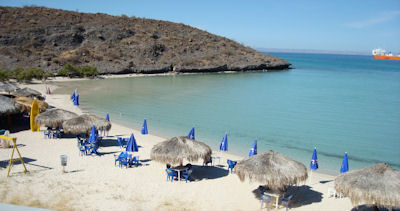
When people ask what my favorite place in Baja is, my first question is favorite for what? I have favorite fishing spots, favorite secluded coves, and favorite palm canyons. But to visit over and over again, I’ve long liked La Paz.
As the capital city of Baja California Sur, it is large enough to find great restaurants, shops, activities, and history. It is still small enough to retain its provincial charm.
I first visited La Paz in the early 1970’s, flying down shortly after a divorce and found magic in that balmy seaside town. It was the warm evenings, warm people, beautiful women strolling the malecón (waterfront walk), pelicans diving for bait fish, and spectacular sunsets. There were just a handful of tourists, mostly Mexicans from the mainland, and the few visiting gringos were friendly. There was also no in-your-face touting, and I quickly felt totally at peace.
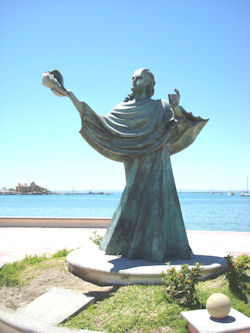
During the mid-70s, on two occasions I drove Baja’s narrow new Highway 1 to that city just 100 miles north of Cabo San Lucas. Then over the next 35 plus years I visited La Paz numerous times, sometimes flying, sometimes driving, sometimes exploring, researching, or promoting books, and other times snorkeling, fishing, or just kicking back.
La Paz wasn’t always so peaceful, however. After hearing tales of pearls and wealth in this “island” to the west called Calafia, the conqueror of Mexico Hernán Cortés used some of his own wealth, took three ships, about 500 Spanish colonists and set out to colonize the new land. On May 3, 1535, the party landed in what Cortés called Santa Cruz, the northeast corner of La Paz Bay.
The Cortés party found abundant oyster beds which led to a long-time pearling industry.
From the start, Cortés had problems supporting the colony. Not only were they harassed by the hostile native Guaycura attacks, but they found the land too arid to support them. The leaders made a trip to the mainland for support. When they finally arrived back in Santa Cruz, they discovered 23 of the colonists dead from starvation and a few others soon died from gorging themselves when food arrived.
The colony built a church and housing, but could not sustain themselves from the land nor count on consistent supplies. Cortés abandoned the colony and the last of the colonists returned to the mainland in 1536.
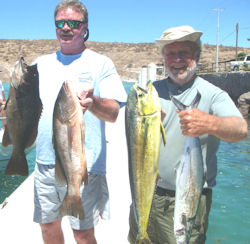
Sixty years later, in 1596, the explorer Sebastián Vizcaino set up a colony at Cortés’ old site of Santa Cruz. Vizcaino renamed it La Paz (Peace) because at first he found the natives so peaceful. It didn’t stay that way, though, as the locals proved anything but peaceful. Once his soldiers started molesting the Indian women, fights started and people on both sides were killed.
From that dubious history, a city grew, and it became the capital of all the Californias in 1829 after Loreto was devastated by a hurricane. Today, with a population of 250,000, it remains the capital of BCS.
By 1950, the pearl fishing that sustained the town for many years had died out, but not before 1940 visitor John Steinbeck based one of his stories, “The Pearl,” there.
In recent years the Americans and Canadians who had bypassed the place for the trendier Los Cabos region have discovered the city’s charms.
In addition to great snorkeling and diving, there’s world class fishing nearby. I’ve caught marlin, sailfish, dorado, tuna, wahoo, roosterfish, and pargo on trips out of La Paz.
On my 2010 visit I went out with both Fishermen’s Fleet owned by David Jones, and Baja Pirates. Another expert is Tailhunter International Sportsfishing run by fellow outdoor writer Jonathan Roldan. Jonathon also has a great restaurant right on the malecón.
Todos Santos booming
On an April 2008 visit, we took a day trip to Todos Santos, an art colony about 90 miles south. That charming fertile valley by the Pacific has a long history from missionary days and sugar plantations, but today the thick walled buildings house art galleries and gift shops. Snowbirds from the Pacific Northwest and Canada have been snapping up every bit of land and construction is booming.
Just two years later, in 2010, I noticed there were yet more shopping galleries, restaurants, and services. Todos Santos was awarded the Pueblo Mágico designation in 2006 establishing it as one of Mexico’s treasures. My estimation is that the size of the town had tripled in just a few years. That’s a long way from my first visit and a palapa restaurant with a dirt floor and chickens at my feet.
What was a knarly dirt road north from Cabo San Lucas in the 1970s is now paved, widened and traveled regularly by day-trippers from both La Paz and Cabo San Lucas. I was able to revisit Janet Howey and do a book signing at her wonderful bookstore, El Tecolote Libros.
Todos Santos accommodations run the gamut from B&Bs to the trendy Todos Santos Inn downtown. There is also a good value Santa Rosa Hotel, the Hotel California, and on the beach, Posada La Poza. South of town is the outstanding Rancho Pescadero where I stayed in 2010.
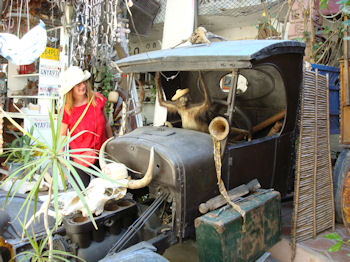
La Paz – From Upscale to Funky
Back in La Paz I noted there are still few major resorts like one finds in the Los Cabos region. A relatively new exception wowed me. It is the Costa Baja Resort and Spa on the road to Pichilingue. It’s a beautiful upscale place complete with a small marina and golf.
Closer in on the outskirts of town are the La Concha and Marina hotels. Good values are the Araiza Palmilla and Club El Moro nearby. Right downtown are the La Perla (the remodeled original hotel in town), and the Seven Crown. It’s a shame that an old favorite of mine, the Los Arcos Hotel has been closed for several years now following a labor dispute.
The old Gardenias Hotel, a few blocks from the water, has been renamed the Bugambillas and has been remodeled. Rooms with new tile and beds are small and still not exciting, but good value. The best value, and more a hostel, is the funky Hotel Yeneka right in the heart of town. The place is so cluttered with junk and souvenirs you could spend a week there and not see all the objects hanging from the rafters and stairways.
There are numerous seafood restaurants, from the Mar y Peña to the Bismark and El Taste as well as world class and crowded taco carts. I also enjoyed dinner and a killer sunset at the Roldan’s 3-story bayfront Tailhunter Restaurant.
A wonderful culinary surprise in La Paz is the French restaurant La Bohéme. Located downtown on a side street, patio dining in that old colonial building is a delight.
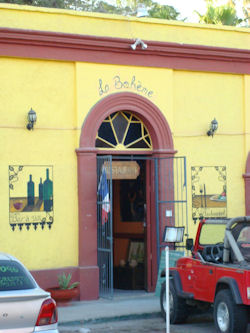
Change is in the air
It was nice to see some familiar things, because there has been change. Most spectacular is the development of the mogoté, the sand spit peninsula across the bay from town. Condos and a hotel called Paradiso del Mar opened on that low-lying land a short distance but a very long drive away. They take people over there in a 10 minute boat ride from the malecón.
The Grand Baja Spa and Resort just out of town has been remodeled from the old Gran Baja Hotel and 123 beachfront condominiums have been added. There are also new condos at Vista Coral & Marina Estates and La Cocha Pearl, and custom lots and homes have been sold at Moravia Golf & Country Cub.
I met the new owners of Allende Books located in an old colonial building at Independencia 518, between Serdán and Guillermo Prieto. Bruce and Kathleen Bennett offer a lot of books in English and enjoy meeting visiting gringos. Allende Books was originally established by Diane Carmona on Calle Allende. www.allendebooks.com. Now on Independencia, the bookstore shares the same historic building with a small B&B called El Angel Azul.
Over the past decade the malecón has been widened and art sculptures now grace the walkway at strategic locations. When the sun goes down, the paceños still set off on their evening strolls. The quiet of the balmy evenings is often shattered a bit by young men in cars cruising the route. The tradition has changed a little bit to accommodate a more mobile population.
Nevertheless, the bucolic and easy living of La Paz is a real magnetic pull.
About Greg
Greg Niemann is the author of Baja Fever, Baja Legends, Palm Springs Legends, Las Vegas Legends, and Big Brown: The Untold Story of UPS. Visit Greg's website.

No claims but purchase was quick and simple.

Super-easy and instant. Very happy with initial purchase.